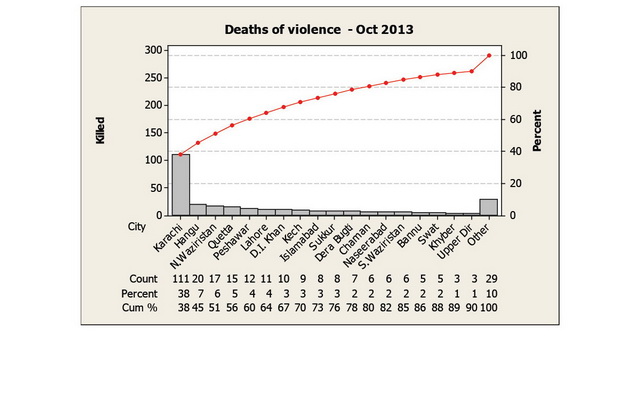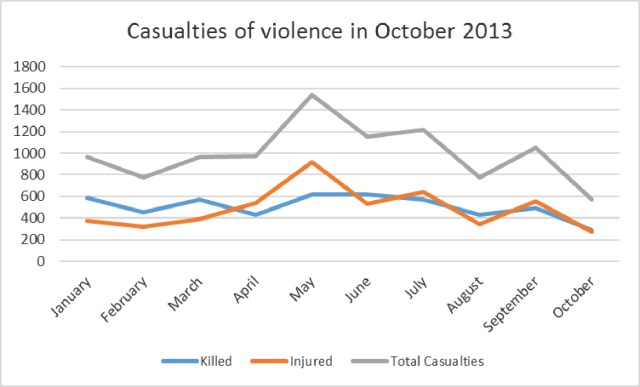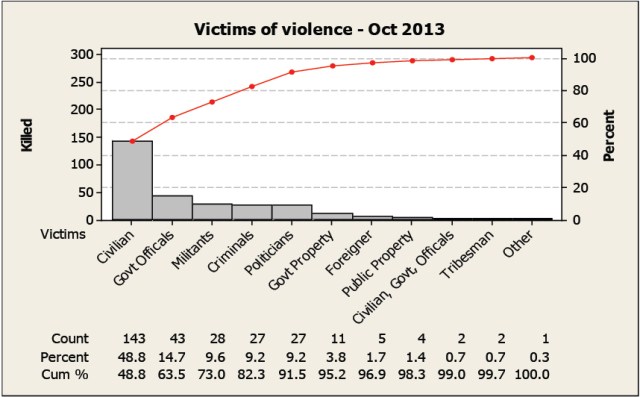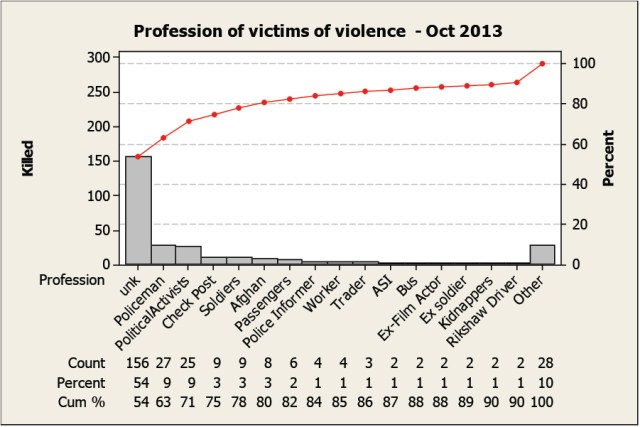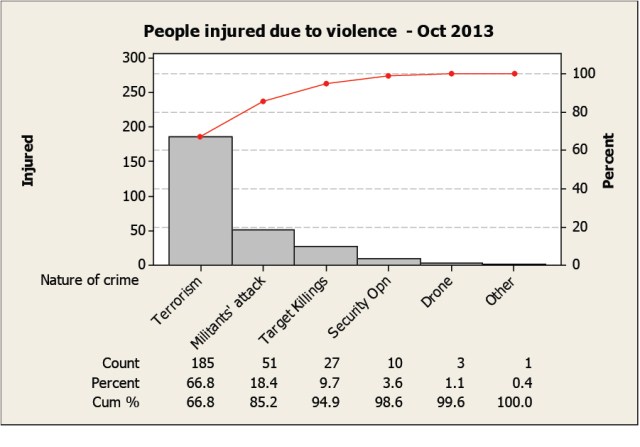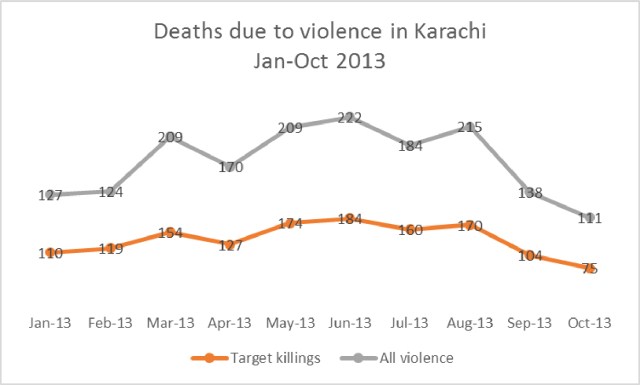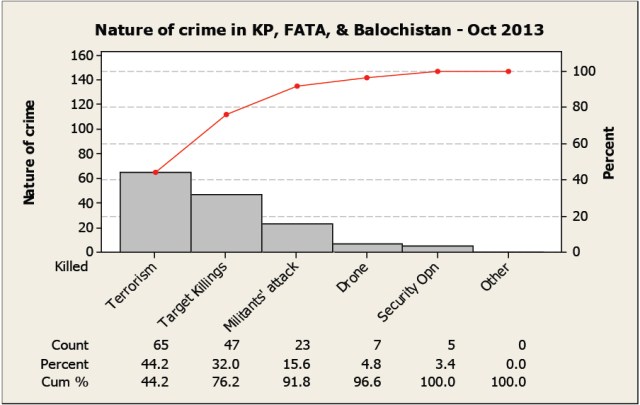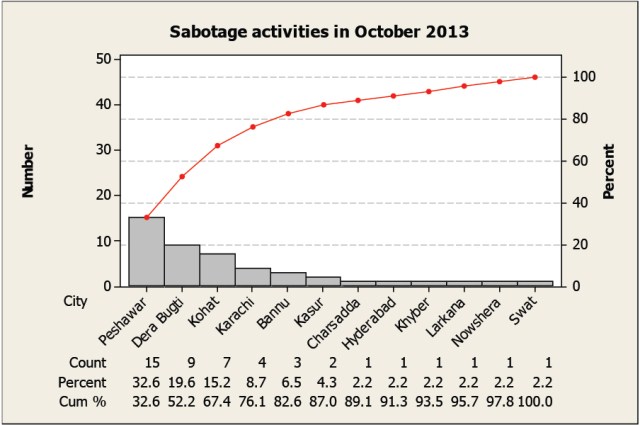The month of October witnessed a significant decline in violence-related casualties bringing some relief to the terror-ridden people of the country. However, the issues related to security and peace remained most common topics of attention for the people and media alike. To tackle terrorism and heinous crimes in the country, the President promulgated the Protection of Pakistan Ordinance on 21st October 2013 that met with a mixed reaction of approval and disapproval from different political quarters.
While the country was debating the new counter-terrorism ordinance, Prime Minister Nawaz Sharif hopped on a trip to the USA with a resolve to convince the US administration to stop drone strikes in Pakistan. To the dismay of the PM and his team, the communique issued after his meeting with President Obama carried no mention of drone attacks that motivated many critics to call the visit a failure.
The polio eradication programme, facing threat of the militants– attack, reached an alarming situation where a ban on foreign travels by the Pakistani nationals became a possibility and vulnerability of a large number of children to become victims of polio attack left many parents to live in a state of fear. Amid these threats and other crimes of the militants, the subject of holding talks with the outlawed Taliban continued motivating the government to give peace a chance. The pros and cons of such a venture invited debates in media and, in most of the cases, the ideological identity rather than the nature of heinous crimes remained a deciding factor in taking any side. While the victims of violence continued losing their lives, the militants enjoyed having unconditional assurances from the government for a reconciliatory talk with them.
All these events and many other facts reported in national newspapers are collected to make this report as informative and factual as possible. Errors and omissions, as always a possibility in all statistical works including this one, are expected. However, such mistakes do not grossly affect the basic objective of this report. This report mainly covers the following topics:
Targeted operation in Karachi
Counter-Terrorism (Pakistan Protection) Ordinance
Militants– attacks
Incidents of sabotage
Polio vaccination and terrorism
Drone attacks
CRSS will appreciate receiving comments that the readers may have on this report.
Report prepared by:
Mohammad Nafees
Senior Research Fellow
Center for Research and Security Studies
Data compilation by:
Fariha Farry
NOTE: Readers can approach CRSS for source of any information included in the report. Please send your request to: [info@ crss.pk]
OVERVIEW
Deaths due to violence in the country during October 2013
The violence-related casualties in October 2013 came down to 568 (291 dead and 277 wounded) from 1,048 that were reported last month (September), a reduction of almost 50% in crime rate (See Graph 1 and Table 1). These casualties (568 persons) for the whole month of October were even less than the casualties reported during the last nine days (610 persons) of September. However, it remained to be seen as to whether this improvement in law and order situation would last long or it will turn out to be a temporary phase of calm waiting for another opportune time to resurface.
Graph 1: Violence-related casualties in the month of October 2013
Table 1: Monthly breakdown of casualties of violence
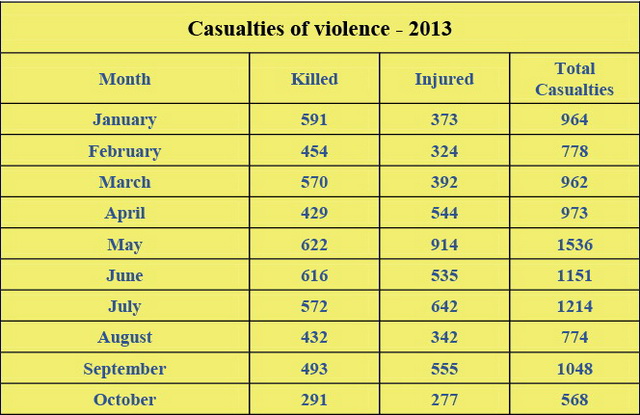
Graph 2: Number of people killed in the provinces due to violence
 In this month, Sindh counted more deaths than KPK and Balochistan combined. Like always, the Punjab and the Capital enjoyed relatively peaceful situation compared to the rest of the country (See Graph 2). On district level, Karachi lost the highest number of people to violence compared to all other districts of the country. (See Graph 3).
In this month, Sindh counted more deaths than KPK and Balochistan combined. Like always, the Punjab and the Capital enjoyed relatively peaceful situation compared to the rest of the country (See Graph 2). On district level, Karachi lost the highest number of people to violence compared to all other districts of the country. (See Graph 3).
Graph 3: Number of persons killed in cities
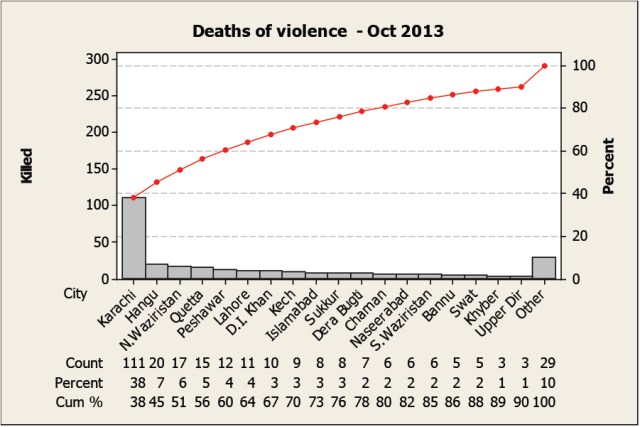
Graph 4: Victims of violence in October 2013
Graph 5: Victims of violence in October 2013
Graph 6: Affiliation of the victims of violence in October 2013
Graph 7: Nature of violence in Pakistan ´ October 2013
Target killing was one of the major causes of deaths followed by acts of terrorism, militants– attack and the counter-terrorist operation by the security agencies. The highest victims of target killings were reported from Karachi (75 persons), KPK (17), Balochistan (19), Punjab (11), Capital (8), and FATA (3). This scenario of violence looked different when we counted the number of people wounded due to different acts of violence in the country. The incidents of terrorism and militants– act caused injuries to 236 people while target killings resulted in wounding 27 persons during this month. (See graph 8)
Graph 8: Number of people injured due to violence in October 2013
Targeted operation in Karachi
Despite ongoing security operations in Karachi the menace of target killings is still taking its toll in the city though a significant reduction in the number of victims has been observed since the PM gave a go-ahead for an operation in September 2013 (See graph 9).
Graph 9: Target killings in Karachi ´ Jan-Oct 2013
The declining graph of both kinds of violence, target killings and all other acts of violence, is a proof that the targeted operation against the criminals is yeilding positive results and it is also proving a point that a well-planned and and indiscrminite security operation against criminals can improve law and order situation in the country if all stakeholders, political and religious parties and civil and military administrations, reach a consensus that violence under any name won–t be acceptable for any reason. Unfortunately, the country is highly divided on this subject.
The resolution of the APC that granted militants the title of ‘stakeholders’ turned the table in favour of the militants and it was further strengthened when the government announced its counter-terrorism policy without having any definition for acts of terrorism. If violence in Karachi can be a cause of concern for the government and other stakeholders, why does the similar or worst kind of violence in other parts of the country fail to raise a similar reaction from them? This contrast in the government policy to deal with violence has been a cause of concern for a long time and most of the anti-terrorism steps the government has taken are reflective of a similar dichotomy.
Counter-Terrorism (Pakistan Protection) Ordinance
On 21st October 2013, the President of Pakistan promulgated the Pakistan Protection Ordinance to counter terrorism and heinous crimes in the country. The ordinance defined all terminologies except the terminology of terrorism as to what act would fall into this category that will make this ordinance applicable. Interesting was the definition of ‘Enemy alien’:
‘Enemy alien’ means a person who fails to establish his citizenship of Pakistan and is suspected to be involved in the waging of war or insurrection against Pakistan or depredation on its territory by virtue of involvement in offences specified in the Schedule.’
This was in line with the common concept that the country is facing a war waged against it by the aliens. If it is true, then the people need its proof and an answer to a very logical question as to why the APC resolution called for holding negotiation with the ‘stakeholders’ when the aliens are waging war against the country. A good example in support of such a concept is a statement of Jamaat-e-Islami, a coalition partner of PTI in KPK government, that held ‘external hands’ responsible for the attack at a church in Peshawar in which 87 persons (officially) were killed (the unofficial numbers are much higher than this)[1]. The Chief Minister of KPK Pervaiz Khattak went one step ahead of the JI and said, ‘…over 200 bomb blasts had taken place in last 10 years and no one had the information as to who were behind the attacks[2].’ By making such a revelation, the Chief Minister had failed to realize the controversy he had created for the negotiation policy his government has been pursuing very enthusiastically. On what reasons do they want to hold peace dialogues with the Taliban when they are not sure of their involvement?
Although the ordinance is silent about the non-aliens who are involved in the waging of war or insurrection, the data we collected shows that a number of non-aliens (Pakistani citizens) are found involved in activities that fall in this category and majority of such incidents occur in KPK, FATA, and Balochistan. Even the Capital of the country is not safe from elements which keep planning and executing programmes detrimental to the people and the country. On 12 October, Islamabad Police and intelligence agencies discovered a drone project, an invention of the al-Qaeda chapter in Pakistan, and halted this ambitious project of al-Qaeda. The Islamabad Police also recovered a huge quantity of arms and ammunition from a house that belonged to Professor Irtyaz Gilani, a graduate in electronic engineering from Ghulam Ishaq Khan (GIK) University, who has also served in the Air Weapons Complex, Kamra[3]. This incident occurred at Bara Kahu where a couple of months ago a failed attempt was made by a suicide bomber to explode into a mosque and Imambargah on Eid day after Juma prayer. According to the IGP, Islamabad, the bomber belonged to a banned militant group linked with the Tehreek-e-Taliban Pakistan (TTP)[4]. Bara Kahu is very close to Diplomatic Enclave in Islamabad and one can imagine what plans these militants must have had in their minds when they were working on such a programme. Now that the key person involved in this programme was suspected to be a Pakistani national and had worked at a most sensitive national security complex, how would the Protection of Pakistan Ordinance deal with such Pakistani citizens?
While the government continues pursuing a policy of reconciliation with the militants, incidents of this nature warn against the intrinsic danger in such efforts especially when the plans and programmes of militants show no signs of their willingness to have peace in the country. It also proves that terrorism and insurgency at locations other than Karachi are more serious issues than the incidents of violence in Karachi. A comparative analysis of the nature of violence in the country shows that target killing is the major cause of deaths in Sindh while KPK, FATA, and Balochistan are more affected by terrorism, target killings, and militants– attack (See graph 10 and 11).
Graph 10: Nature of violence in Sindh – October 2013
Graph 11: Nature of violence in KP, FATA, & Balochistan – October 2013
Militants– attack
Drone attacks and militants– attacks are two forms of violence that divide the nation on what to defend and what to condemn. While there is a broader consensus in the country on the negative impacts of drone attacks, the attacks carried out by the militants are seldom condemned by the people and media though the casualties in such attacks are far more in number than those in drone attacks. This month the ferocity and frequency of militants– attack were not as high as it was during the previous month. Major attacks reported during this month were:
6 October 2013:BANNU: Three security personnel were killed and 8 others injured as a security forces convey was attacked in Bakakhel area near FR Bannu.[5]
15 October 2013:QUETTA: A dozen people were injured when unknown men lobbed a hand grenade at a Balochistan Constabulary vehicle on Mastung Road on the edge of Quetta city.[6]
19 October 2013:MINGORA: Two persons were killed and 12 others were injured when unidentified persons opened fire on a vehicle in Kabal Tehsil in Swat district on the first day of Eidul Azha.[7]
21 October 2013:PESHAWAR: Four police officials were killed in a drive-by shooting on a checkpoint on Ring Road. Four gunmen riding on two motorcycles opened fire on police officials manning the checkpoint located in the jurisdiction of Pahripura police station.[8]
26 October 2013:BANNU: A group of armed militants equipped with automatic weapons attacked Hawad police station here, killing one person on the spot.[9]
26 October 2013:MASTUNG: Two Frontier Corps (FC) personnel were killed in a bomb attack on a bus carrying pilgrims in Darengarh, Mastung.[10]
29 Oct 2013:DERA BUGTI: At least seven people were killed and five others were wounded in an attack at the residence of a tribal leader situated in Loti Zain area of Balochistan’s Dera Bugti district. Those killed in the attack included women and children.[11]
30 Oct 2013:MIRANSHAH: Security forces killed nine terrorists who attacked a check-post in Miranshah, North Waziristan. Separately, three soldiers were injured due to explosion of an IED planted on the roadside by terrorists on Tank-Tandolar road in South Waziristan.[12]
30 Oct 2013:QUETTA: Militants attacked a house located near Awaran where rescue teams were stationed.[13]
Incidents of sabotage in the country during October 2013
Another aspect of violence is the acts of sabotage carried out by the militants and other unlawful elements in the country. The analysis of sabotage activities in the country also reveals that KPK and Balochistan are more affected by it than Sindh. All those incidents that were not fatal to human lives were included in this assessment and the results showed that during this month, 22 bombs were defused, 13 bomb explosions that damaged properties or wounded some people, 5 reports of seizure of explosives, 2 incidents of setting the property on fire, 2 suicide jackets were defused, and 2 toy bombs were defused. The districts where most of the sabotage activities took place are shown in the graph 12 below.
Graph 12: Districts affected of sabotage activities in October 2013
Polio vaccination and terrorism
Another crisis facing the country is directly related with the ongoing acts of terrorism and militancy that have endangered the life of hundreds of thousand children who remain unprotected from polio disease due to a ban imposed by the Taliban against polio vaccination in the country. According to a report, nearly 350,000 children have been left without polio vaccination due to Taliban ¿boycott–. 290,000 of them are in North and South Waziristan. In addition to the ban from the Taliban, a mindset negative to polio vaccination has also been observed in many places in the country. During the September 2013 campaign, the total number of refusals stood at 65,423, of which 1,073 are in the Punjab, 18,639 in Sindh, 36,923 in KPK, 530 in FATA and 8,001 in Balochistan. Nearly 50% of these refusals came from KPK and FATA while in the Punjab, the majority population province of the country, such refusals were very low.
Drone Attacks
Drone attacks remained as one of the most talked about topics of the month. In the first week of October, the Taliban spokesman said, ‘..any ceasefire must include an end to the US drone attacks in tribal areas, which have been targeting suspected Taliban and al-Qaeda militants since 2004.’[14] Interesting to note was an upsurge in militants– attack before the PM visit to the USA. The Taliban and their affiliates stepped up their attacks during the last ten days of September 2013 resulting in deaths of 212 persons and injuries to 364 persons in the country, most prominent among them were attack on Peshawar Church, bomb explosion in a bus carrying government staff from Peshawar to Mardan, and twin blasts in Qissa Khawani Market of Peshawar. Were these killings carried out by the militants to influence the government to include Drone attacks in the agenda for the Prime Minister upcoming visit to the USA? Whatever be the reason, the consensus of the TTP and the Pakistani government on this issue faced a serious setback when US Congressman Alan Grayson made a revelation that the Drone attacks are carried out with the consent of the government of Pakistan. He also claimed that the strong Pakistan Air Force is capable of restricting any aerial intrusion in the country as and when it decides to[15]. While a debate on drone strikes was going on and reports from the UN and Amnesty International on the subject were making headlines, a drone strike on 31st October killed Hakimullah Mehsud, the chief of Tehreek-e-Taliban Pakistan and left peace initiative of the government into limbo.
Conclusion
The targeted operation in Karachi has brought down the incidents of violence in the city. A downward trend in occurrence of violence is also observed in other provinces too, most probably due to high level of vigilence maintained by the security agencies.
The most talked about peace negotiation with the Taliban received a serious blow this month when a drone strike ressulted in death of the Taliban chief, Hakimullah Mehsud. It may revive a revengeful violence in the country if our security agencies and their intelligence wings fail to take effective preventive measures.
Dichotomy in dealing with one and the other form of violence is one of the main reasons why the government fails to tackle the menace of terrorism and insurgency in the country.
To deal with violence in Karachi, the government and all political parties had a consensus on a non-discriminatory and across-the-board target operation. The Federal Interior Minister Chaudhry Nisar Ali Khan, called for an ‘immediate’ action against four heinous crimes in these words: ‘All I would say is that there will be a targeted operation ´ wherever there are extortionists, target killers, kidnappers for ransom and terrorists[16].’
To deal with the menace of terrorism, militants– attack and insurgency in KPK, FATA and Balochistan this resolve turned into a call for ‘initiation of the dialogue with all the stakeholders forthwith[17]‘. Despite continuation of militants– attack on security check posts, public transport, government installations the government has been staying firm on its resolve to give ‘peace a chance’. Will this duality of approach in dealing with the unlawful elements serve well for a lasting peace in the country? There is a nationwide divide on this question and the time would only decide as to how far this action was suitable.
[2] http://www.thenews.com.pk/Todays-News-13-25979-Foreign-involvement-cant-be-ruled-out-in-terror-acts-in-KP
[4] http://images.thenews.com.pk/12-08-2013/ethenews/t-24726.htm
[5] http://www.dawn.com/news/1047864/three-killed-and-8-injured-in-bannu-convoy-attack
[11] http://www.dawn.com/news/1052661/attack-on-tribal-leaders-residence-in-dera-bugti-kills-seven
[12] http://www.dailytimes.com.pk/default.asp?page=2013\10\30\story_30-10-2013_pg7_5
[13] http://www.dawn.com/news/1052925/rockets-fired-at-rescue-team-near-awaran
[14] http://www.thenews.com.pk/Todays-News-13-25823-Ceasefire-sans-halt-to-drone-strikes-unacceptable-TTP
[15] http://www.thenews.com.pk/article-124458-Drone-strikes-can-end-tomorrow,-if-Pakistan-wanted:-Grayson

